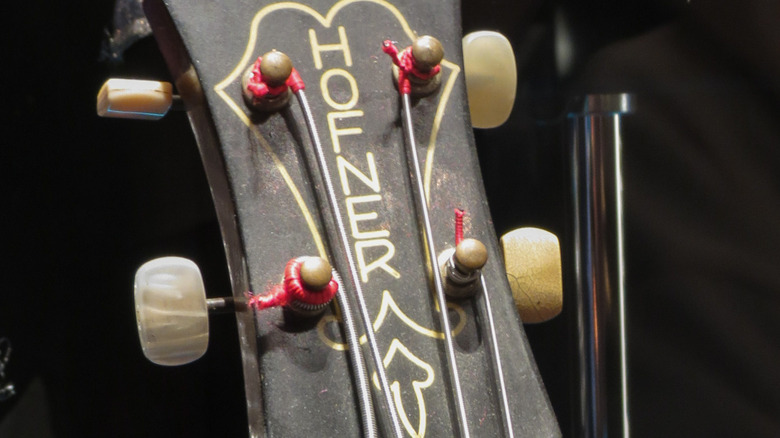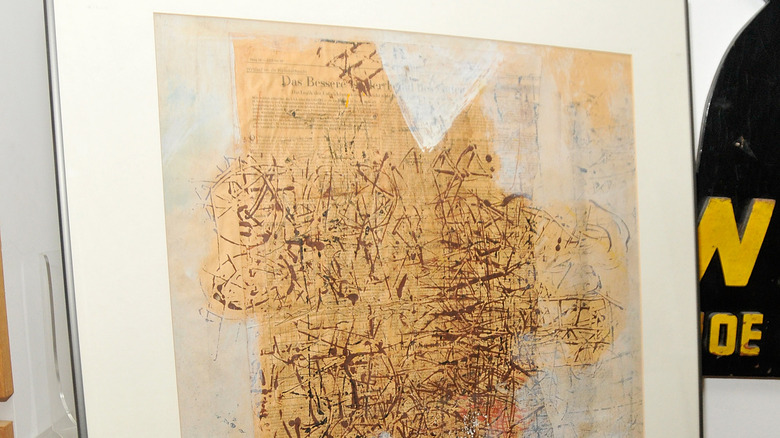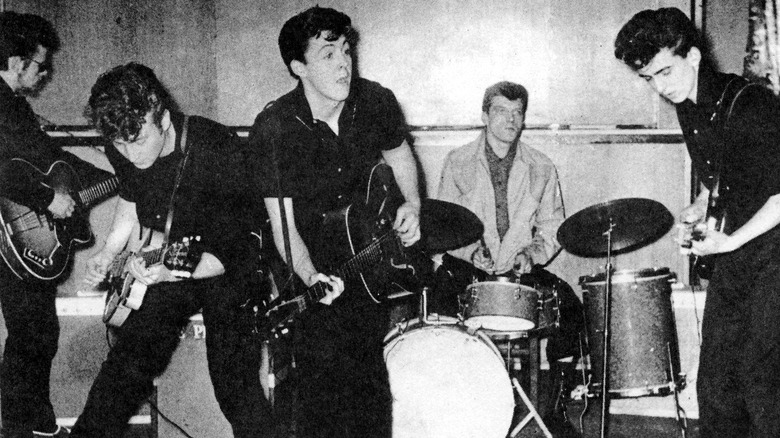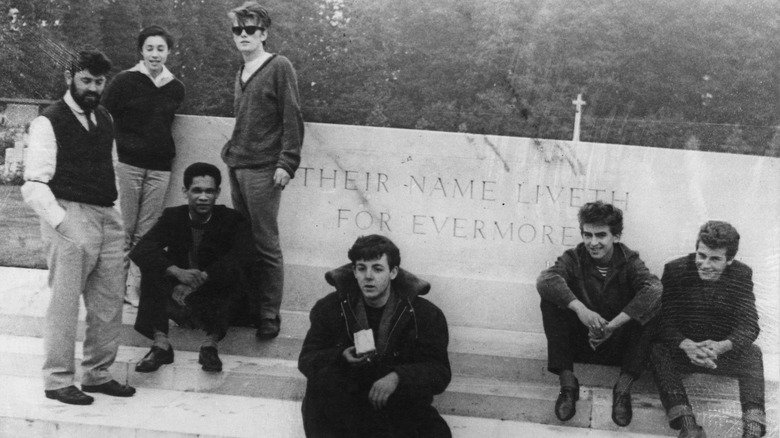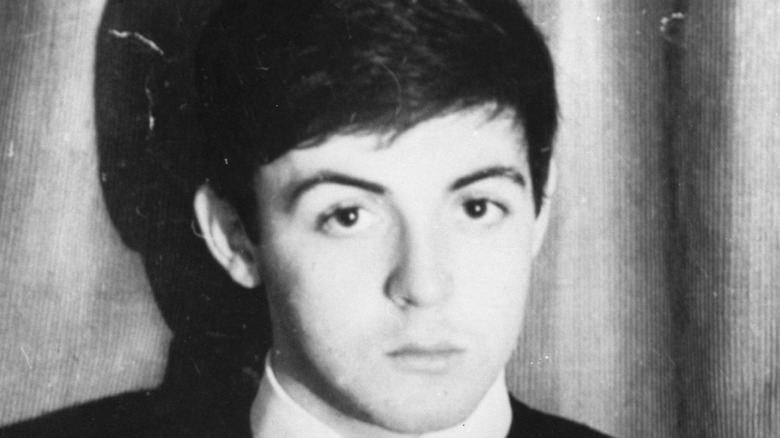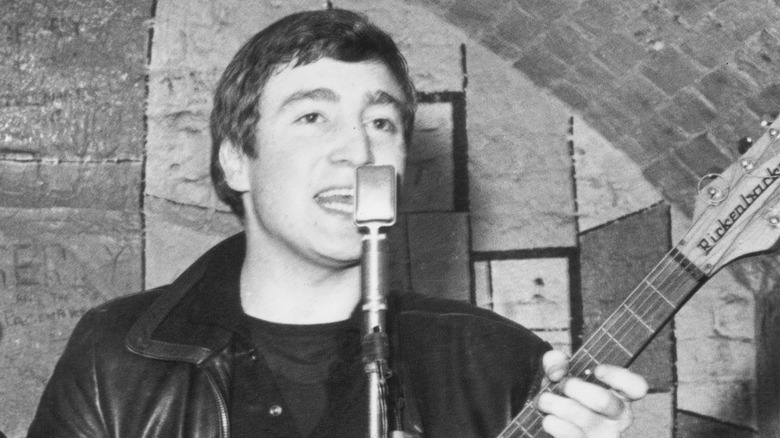The Tragic Life Of The Beatles' Little-Known Original Bassist, Stuart Sutcliffe
During their six-year run as the leaders of the British Invasion that swept the rest of the world, the Beatles were a band made up of four men — John Lennon, Paul McCartney, George Harrison, and Ringo Starr. They became so ubiquitous that anyone can call them by their first name, in that particular order, and immediately associate them with all things "fab." But there were other individuals who were part of the band before they made it big, or had a close working relationship with the Fab Four during their heyday. Pete Best was their drummer before he was replaced by Starr. Billy Preston, while never officially a part of the group, played keyboards on some of their late-period songs and was often known as "the fifth Beatle." Then there was the literal fifth Beatle during the early years of the band — Stuart Sutcliffe.
At the time they officially became the Beatles, Sutcliffe had been playing bass for the group for several months, with Lennon, McCartney, and Harrison all playing guitar and multiple drummers keeping time before Best joined on a full-time basis. Sutcliffe's time with the Beatles was brief, but nonetheless quite impactful, and his death in 1962 marked the end of a life that was so full of promise, yet marked by a number of challenges, especially in the months leading up to his passing.
Sutcliffe was an art prodigy before he was a Beatle
Stuart Fergusson Victor Sutcliffe was born on June 23, 1940, in Edinburgh, Scotland, but was raised in the Beatles' hometown of Liverpool. As noted by his biography in the Beatles Bible, Sutcliffe's art skills were evident from a young age, and he would go on to enroll at the Liverpool College of Art — the photo above shows one of his paintings at an auction. It was at the Liverpool College of Art where he first met John Lennon through a mutual friend, would-be music journalist Bill Harry. "With me, Stuart and Rod [Murray, another student], the four of us called ourselves The Dissenters," Harry recalled in a BBC article. "We used to talk about art and literature and read books by the San Francisco poets and the Olympia press in Paris."
Late in 1959, one of Sutcliffe's paintings was selected for the John Moores exhibition at the Walker Gallery in Liverpool. The artwork, titled "The Summer Painting," impressed Moores so much that he purchased it for £65. For a 19-year-old art student, that was not a small amount of money. At that point, Sutcliffe had already made the acquaintance of Lennon's bandmates Paul McCartney and George Harrison, and reluctant as he was to heed their suggestion, he was persuaded to use the money on a Hofner bass guitar ... and join the band as their new bassist.
He helped the nascent Beatles in a big way, but wasn't a natural musician
Soon after joining Lennon, McCartney, and Harrison, Stuart Sutcliffe proved to be a useful addition to the band as they vacillated between names. He would allow the group to rehearse at his flat and would get them some gigs, serving as a de facto manager or booking agent. He also hooked them up to a very important connection in their pre-Beatles existence; per The New Yorker, he was hired by Allan Williams, the owner of a new cafe called the Jacaranda, to paint over the graffiti in the establishment's ladies' room. Williams would soon start booking the soon-to-be Beatles at the Jacaranda and take over management duties in a more official capacity.
Most importantly, Sutcliffe is credited with helping come up with the Beatles' eventual band name. "Stuart was saying, 'We play a lot of Buddy Holly numbers, how about a name like Buddy Holly's backing band The Crickets?' And John said, 'Yeah, let's think of insects'. So they tried The Beetles. It was in August 1960 that they finally decided on The Beatles," recalled Bill Harry in his BBC piece.
One can say that Sutcliffe's behind-the-scenes contributions played a big role in making up for the fact he was not as musically gifted as his bandmates. "He wasn't a musician at all until we talked him into buying a bass," Harrison said in "The Beatles Anthology," as quoted by the Beatles Bible. "He picked up a few things and he practiced a bit until he could get through a couple of other tunes as well. It was a bit ropey, but it didn't matter at that time because he looked so cool."
He put his art ambitions on hold for the Beatles and found love in Germany
With Allan Williams now acting as their manager and Pete Best joining on drums in August 1960, the Beatles got what was their biggest break yet as a struggling young band — an opportunity to play a series of gigs in Hamburg. According to The New Yorker, this posed a dilemma for Stuart Sutcliffe, who was torn between staying in England and continuing his art career or joining his bandmates in Germany. But when Sutcliffe and John Lennon were evicted from their flat due to a sensationalist news report about beatniks in their area, the painter-slash-musician was left with no better option than to make the trip to Hamburg.
During the Beatles' time in Hamburg, the group got to know some of the city's young creatives, including graphic designer Klaus Voormann and his then-girlfriend, photographer Astrid Kirchherr. Despite the initial language barrier between the two, Sutcliffe entered a relationship with (and was later engaged to) Kirchherr after she and Voormann broke up, but as The New Yorker pointed out, this didn't always sit too well with the rest of the Beatles. Sutcliffe's sister, Pauline, claimed to the publication that Paul McCartney was especially insecure that Kirchherr wasn't giving the rest of the band the attention they deserved.
Sutcliffe and Paul McCartney didn't get along
Although it's often been said that Stuart Sutcliffe and John Lennon were the best of friends, that apparently didn't extend to everyone else in the Beatles. It was Lennon's trusted songwriting partner, Paul McCartney, who allegedly had some beef with Sutcliffe, and it wasn't just because of the latter's new relationship; McCartney was supposedly concerned that Sutcliffe's rudimentary bass playing was an anchor on the Beatles' prospects as an up-and-coming band.
Ultimately, tensions reached critical mass between the two bandmates, and Sutcliffe and McCartney had an on-stage altercation that became physical (via Beatles Bible). "I thought I'd beat him hands down because he was littler than me," McCartney said. "But he was strong and we got locked in a sort of death-grip, on stage during the set. It was terrible. We must have called each other something one too many time." Perhaps unsurprisingly given what was noted above, the altercation started because McCartney made some unflattering comments about Astrid Kirchherr, according to Lennon.
Despite all that, Lennon told Beatles biographer Hunter Davies that the Beatles didn't have any mean intentions when they'd mess with Sutcliffe. "We were awful to him sometimes," he said. "Especially Paul, always picking on him. I used to explain afterwards that we didn't dislike him, really."
He quit the Beatles and returned to painting as his health quickly went downhill
After the Beatles' late-1960 Hamburg run came to a disastrous end, the band was back gigging in Liverpool in January 1961. As the story goes, Stuart Sutcliffe was brutally attacked late that month by a gang of local ruffians, who kicked him in the head before John Lennon and Pete Best broke things up (via The New Yorker). The Beatles then returned to Hamburg and played close to a hundred shows in the city from April to July, but they were short one man when they came back home.
Sutcliffe decided to stay in Hamburg, where he was focusing more on his relationship with Astrid Kirchherr and devoting more time to painting. Effectively quitting the Beatles by staying behind, Sutcliffe sold his bass guitar to Klaus Voormann (who later played for acts like Manfred Mann and the Plastic Ono Band) and started studying under Eduardo Paolozzi, a Scottish artist who was teaching at the Hamburg Art School.
Sutcliffe proved to be an excellent student, as Paolozzi described him as "imaginative, ultra-intelligent, and ... open to everything." However, the past few months had also seen his health become progressively worse. In July 1961, he complained about gastritis, lung problems, and a bad appendix in a letter to his mother. He also began to suffer from headaches and blackouts, which progressively became more frequent and intense as the months passed. At that time, he chalked it up to overwork, but even as he stopped attending school after collapsing in class in February 1962, the headaches just wouldn't go away; they had become so severe that he had become prone to violent mood swings and temporary blindness.
Did John Lennon deliver the blow that led to Sutcliffe's death?
On April 10, 1962, Stuart Sutcliffe, then only 21 years old, died in the arms of his fiancee, Astrid Kirchherr, while on the way to the hospital in Hamburg. His official cause of death was listed as cerebral paralysis caused by bleeding in the right ventricle of the brain. It's been theorized that this may have been caused by a blow to the head, possibly when he was allegedly mugged by a group of Teddy Boys in January 1961, as noted above. However, Pauline Sutcliffe believes that someone else might have delivered the blow that led to her brother's debilitating headaches and eventual death.
As reported by The Independent, one of Sutcliffe's sketchbooks, dated October 1961, contains several scribblings where he describes the pain he was suffering due to his headaches. These entries, according to Pauline Sutcliffe, were made after her brother had a violent fight with John Lennon, one where the Beatles singer-guitarist kicked his best friend in the head — similar to the manner in which he was supposedly attacked by the Teddy Boys.
Regardless of whether those claims are true or not, Lennon was devastated by Sutcliffe's death, as evidenced when the Beatles kicked off another series of Hamburg shows shortly after their former bassist's passing. "John went into hysterics," Kirchherr said (via The New Yorker). "We couldn't make out ... whether he was laughing or crying because he did everything at once. I remember him sitting on a bench, huddled over, and he was shaking, rocking backward and forward."
